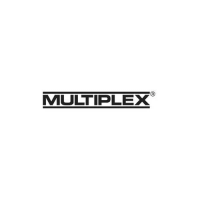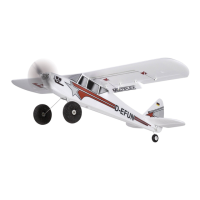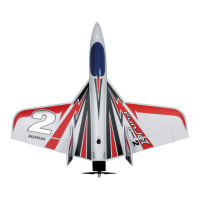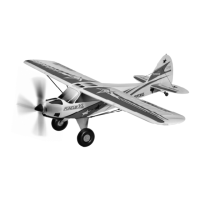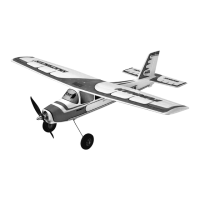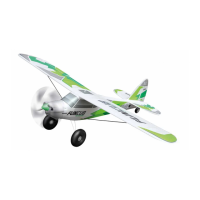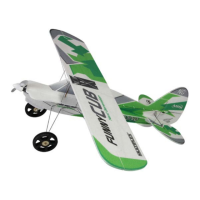22
struts can be securely inserted into the opposite n when assembling
the model.
30. Sticking the leading edges to the wings
From the wing tip, rst stick on the outer leading edge segment
㊷
/
㊸
.
To do so, place the wings on the table so that the front area protrudes over
the edge of the table. Now draw continuous 'tracks' of Zacki ELAPOR®
on both sides, inside the leading edge, approx. 2 mm away from the
edge. Position the hollow needle of the adhesive on the opposite edge
to the guide and apply adhesive in a straight line. Position the leading
edge from the outside on the wing and press on with your ngers for
some time, sliding your ngers up and down. If necessary, remove any
escaping glue. Proceed in the same manner with the inner leading edge
segment
㊵
/
㊶
.
Fig. 25
31. Mounting the wing roots / retaining clips
Afx the retaining clips
using the screws
㉞
to the left and right wing
roots
and
inside the protruding border. Slide two O-rings
㊱
8 x
2 mm over the retaining clips on each side so that they are pretensioned.
Fig. 26
32. Mounting the wing roots
Stick the wing roots
/
to the contact surfaces of the wings using
Zacki ELAPOR®.
Press on the ns immediately with both hands forcefully and allow the
glue to set.
Fig. 27
33. Affixing the leading edges to the transition segments
Stick the left and right leading edge lling pieces
㊹
and
㊺
to the wing
roots and the leading edges.
To do so, apply a little glue slightly away from the edge on the inside of
the lling piece and position before afxing. If necessary, remove any
escaping glue.
Fig. 25
34. Reinforcing the ailerons and the flaps
Stick the stainless steel reinforcement tubes
(330 mm) into the
corresponding longitudinal recesses of the wings (rudder aps) (4x at
with CA adhesive). Fix the ends with a bit of hot glue as well.
Caution: At rst, do not apply any glue in the area of the rudder horn
indentations.
Fig. 28
35. Preparing and mounting the rudder horns
Screw the hexagon socket set screws
㉘
into the cardan bolts
㉗
.
For the ailerons (QR), insert the cardan bolts into the outer holes of
the rudder horns
㉖
. When doing so, do not bend the tabs further open
than necessary!
For the camber-changing flaps (WK), insert the cardan bolts into the
inner holes of the rudder horns
㉖
. When doing so, do not bend the
tabs further open than necessary.
CAUTION: Observe installation direction!
Aileron (QR) => armoriented forward
Camber-changing ap (WK) => arm oriented backward
Apply hot glue in the recesses and immediately insert the rudder horns
㉖
and press in fully - if necessary re-stick at the side.
Fig. 28+29
36. Cutting free the aileron and the camber-changing flaps
Cut the rudders free at the front sides using a cutter / backsaw and bend
the rudder aps up and down several times in order to make the hinges
smoother. Under no circumstances may the rudders be separated from
the hinge line!
37. Preparing the aileron servos
Caution: Due to the uneven number of teeth, the servo arms are not
exchangeable by 180° exactly. Therefore, be sure to adjust / mount the
arms on the servo rst, and only then shorten them inversely.
First position the servos electrically into the neutral position. Then mount
the servo arm one tooth turned forward toward the housing (two
servos mirror-inverted). This setting enables the mechanic differentiation
of the ailerons. The differentiation is now mechanically attuned so that the
rudder deections upward are larger than downward.
In addition, the servo arms can be turned again by the same distance
further out of the middle position (offset) using the transmitter. With this
setting, you can achieve even larger deections upward. As a result, even
larger buttery deections can be achieved.
This is helpful for landing in conned spaces or ridge lifts.
Fig. 28
38. Preparing the camber-changing servos (flaps)
For the ap servos, the servo arms are turned into the neutral position
one tooth turned backward toward the housing (two servos mirror-
inverted). The possible deection is enlarged downward as a result!
Here, an offset can additionally be set on the transmitter – the rods are
slightly longer in this case.
Fig. 29
39. Shortening the servo arms
For all four wing servos, the double arms are completely cut off on one
side and shortened on the other. For shortening, cut precisely through
the third hole from the inside so that the two inner holes can still be
used. This can be done most effectively using a small side cutter. For this,
cut off two left and two right / mirror-inverted arms after mounting on the
servos. It is necessary to shorten them to ensure the servo hoods can be
mounted later.
40. Fitting the aileron / camber-changing servos (flaps)
Insert hot glue into the slits for the servo aps and immediately press the
Building instructions
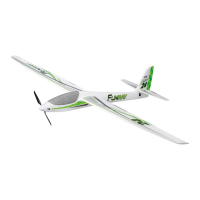
